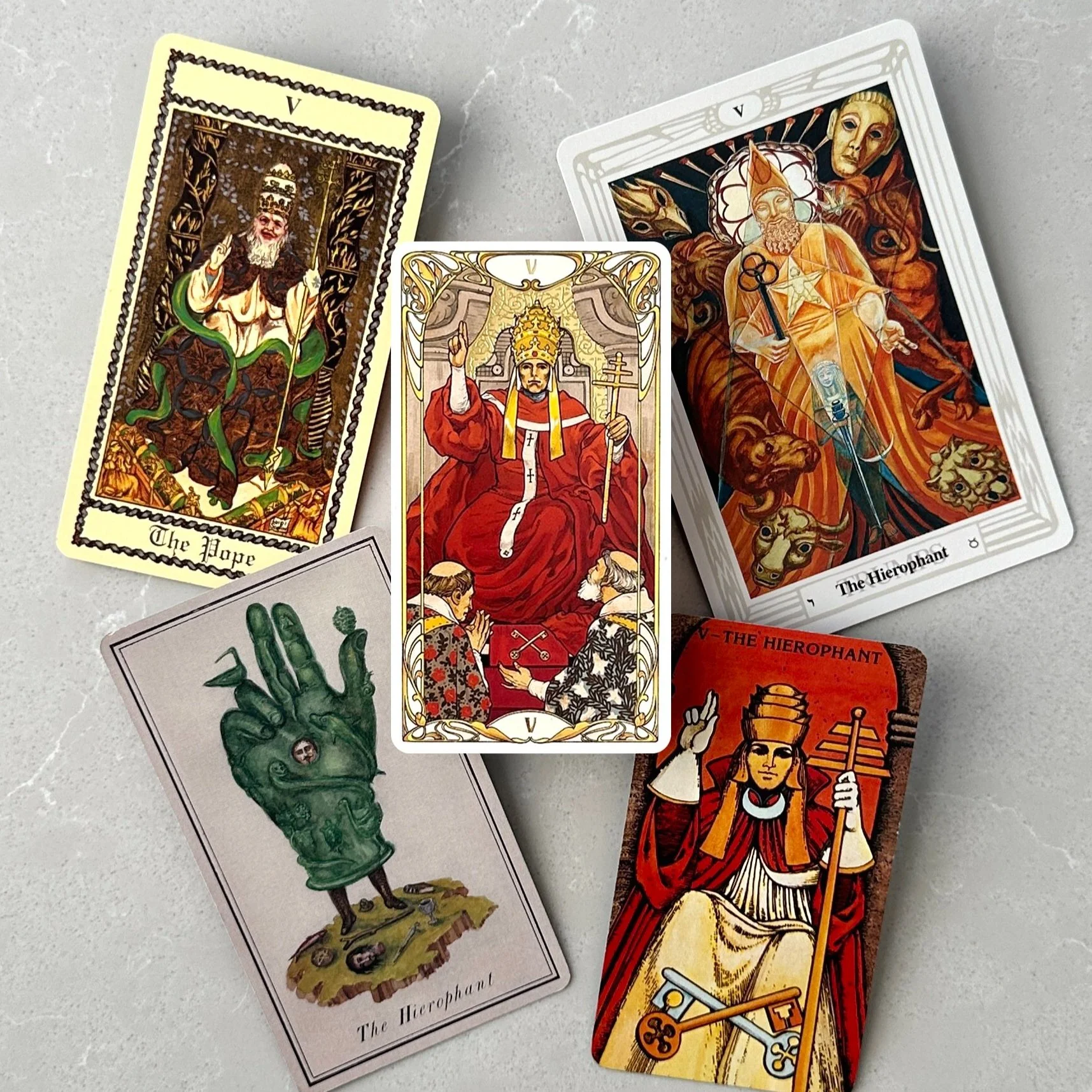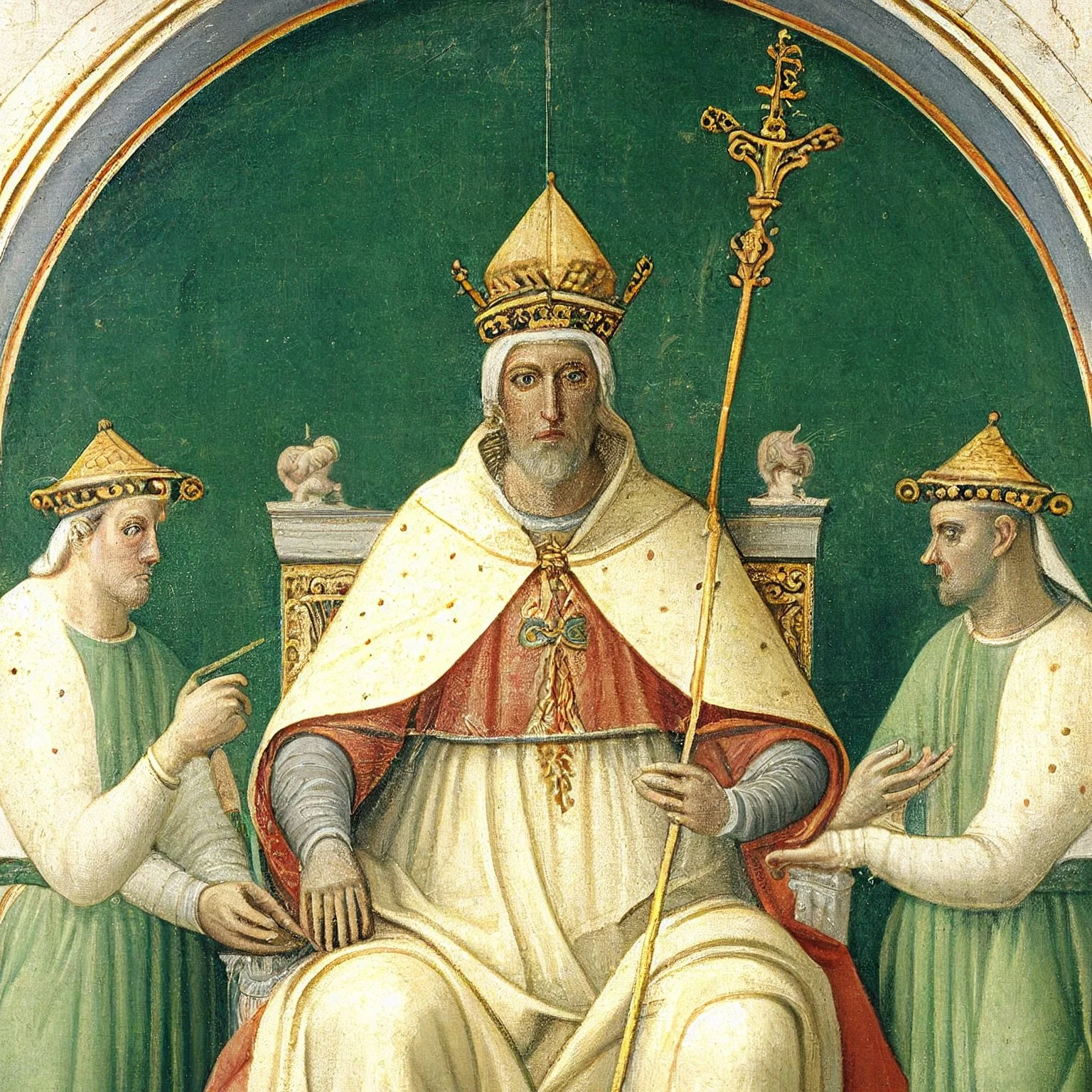From gatekeep to facilitator.
Getting reacquainted with The Hierophant
Growing up in a Catholic family, authority played a fairly large role in my day-to-day life. Even though I attended public school from kindergarten through 8th grade, rules and regulations were always just around the corner, waiting to jump out and hold your happiness hostage. As a typical midwestern family, attending Mass and listening to excerpts from the good book, sitting, standing, kneeling, and parroting prayers from our pews was a mandatory Sunday morning tradition. As the years went on I made the jump to private school, opting for an institution that was run by a sect of priests known as The Jesuits, or the Society of Jesus. Known to some as “hippy priests'', The Jesuits offered an approach with their faith that valued learning about the Universe, rather than fearing it. In fact, 34 lunar craters (and a few asteroids, too) have been named after Jesuit astronomers in honor of their contributions to science. In a recent America Magazine article, Br. Bob Macke, SJ, an astronomer at The Vatican Observatory said that he himself “serve[s] as a sign that scientific pursuits and religious life go hand in hand…There is no conflict”. He then goes on to say that his presence as a scientist and priest “gives others the opportunity to engage…on questions of faith and science and to challenge…assumptions about the relationship between the two.” It wasn’t until high school that the opposition between the blind faith of my family’s parish priest and the thoughtful, intellectual approach of the Society of Jesus encouraged me to think critically, but also weave exploration into my own journey.
The Hierophant, in his most traditional interpretation, is seen as the great connector—an individual that exists in our reality as a link to the Divine. Throughout my own Tarot journey, The Hierophant morphed from a spiritual oppressor to an enlightened facilitator, much like my relationship with religious figures growing up. In her book Seventy-Eight Degrees of Wisdom, Rachel Pollack draws a similar conclusion, stating that this card “can give us a place to start in creating a personal awareness of God.”. This isn’t to say that he is immune to corruption. Absolutely not. Considering the painful and inexcusable actions the Church has taken over many years, it’s no wonder that his relationship with Tarot readers (myself included) is turbulent. However, I’ve begun to challenge myself, taking into consideration where this figure “lives”. For me, the Tarot is a tool used to create the space for reflection, rather than prediction. Its use in opening the human mind to the Universe and collective consciousness is incredibly powerful, such as that of a priest. As Pollack referenced, the Tarot “sets itself against all Churches by leading to personal salvation in this life”, while The Hierophant offers his leadership, mentorship, and expertise to get us there. Yes, The Hierophant might exude quite a few physical and symbolic characteristics of spiritual conformity, but we have to remember that our 78-card deck is his actual house of worship.
For this month’s exploration of The Hierophant, I have selected five decks that show us his this character’s desire to mentor and guide us: the Golden Art Nouveau Tarot by Giulia F. Massaglia, the Morgan-Greer Tarot by Bill F. Greer, the Carnival at the End of the World Tarot by Kahn & Selesnick, The Medieval Scapini Tarot by Luigi Scapini, and the Aleister Crowley Thoth Tarot by Aleister Crowley and Lady Frieda Harris.
The Emperor. Clockwise from top left: The Medieval Scapini Tarot by Luigi Scapini (U.S. Game Systems, Inc.) the Golden Art Nouveau Tarot by Giulia F. Massaglia (Llewellyn Worldwide, Ltd.), the Aleister Crowley Thoth Tarot by Aleister Crowley and Lady Frieda Harris (U.S. Game Systems, Inc.), the Morgan-Greer Tarot by Bill F. Greer (U.S. Game Systems, Inc.), and the Carnival at the End of the World Tarot by Kahn & Selesnick.
The Hierophant drips with iconography, symbology, and gestures linked closely to Christianity. For our purposes, we will touch on three specific instances that are shared by each of these spiritual leaders: the papal cross, the crossed keys, and the gesture of benediction.
Considered to be the overarching symbol of the authority of the Roman Catholic Church, the papal cross also represents the leader of that faith: the Pope. In the hierarchy of the religion, the three tiers of the cross indicate the supreme power of the pontiff, but also represent the Holy Trinity: The Father (God), The Son (Jesus), and The Holy Spirit. Some writers have also suggested that the cross illustrates the domains that the ruler is in touch with, namely the Church, the heavens, and the world at large. In my own experience working with the Tarot from a psychological perspective, the three tiers can also represent the conscious, subconscious, and unconscious minds. However, both The Pope in The Medieval Scapini Tarot and The Hierophant of the Aleister Crowley Thoth Tarot has different symbols atop their staffs. The Pope’s staff shows a two-tiered cross, indicating that although he is labeled the leader of the faith, his staff suggests he is one rung below the overarching ruler, most likely an archbishop. Why would this grinning gentleman omit his true position other than to lord his hollow power over the tiny followers below? It is my belief that the artist, Luigi Scapini, didn’t have the rosiest of relationships with the Roman Catholic faith and chose to depict this “ruler” as a “fibber”. Even the bottom of the staff, jagged and pointed like a bolt of lightning, makes it clear that this “pope” will strike down anyone who stands in his way to assume the throne. Alternatively, The Hierophant in Crowley’s deck takes a much softer approach with his staff, topped with three interlocking rings. In their book, The Crowley Tarot: The Handbook to the Cards, authors Akron and Hajo Banzhaf notes that the three rings “...combine the past, present, and future into a harmonious totality.”, a wide departure from our friend The Pope of The Medieval Scapini Tarot. The three-ring staff held in his right hand opens up the reader’s subconscious, almost as if it was a key unlocking the truths of the Universe.
The Hierophant generated by artificial intelligence.
Speaking of keys, this card is littered with them! Whether they’re front and center in the Morgan-Greer Tarot or smaller and more demure in the Golden Art Nouveau Tarot, crossed keys have a long history within Christianity. Known in the faith as The Keys to Heaven or St. Peter’s Keys, this symbol demonstrates gatekeeping at its finest. As the story goes, Jesus says to Peter, "I will give you the keys of the kingdom of heaven, and whatever you bind on Earth shall be bound in heaven, and whatever you loose on Earth shall be loosed in heaven.” This symbol, along with the aforementioned three-tiered cross, has become another symbol of the Papacy, suggesting that this character has the ability to help us unlock the Universe's mysteries. Again, since we’re looking at this character within the context of the cards rather than as an actual religious figure, the keys are a sign of opening, as opposed to locking.
Within the Tarot, gestures are also important in decoding a card’s underlying meaning, and The Hierophant gives us one major, meaningful expression: The Hand of Benediction. With two fingers up and two fingers down, we understand this gesture almost as a mini-version of The Magician—one arm raised to the sky while the other points to the Earth. Although not a practitioner of magic like his friend, The Hierophant understands the importance of balancing out physical experiences on this planet with our spiritual journey with the Divine or the Universe. Historically this gesture is regarded with “big joiner energy” as there theories (later medically debunked) that St. Paul, the first Pope, had nerve damage to his right hand that was then copied by the following pontiffs. Talk about a set of brown-nosers! Needless to say, this gesture is pretty standard within card five. Artists Kahn and Selesnick seem to have been so inspired by the pose they built an entire costume for their Hierophant, covering him up so much that the use of his arms and hands have been rendered useless. Perhaps this is a reminder or warning for those of us who use the Carnival at the End of the World Tarot: don’t wait around for a blessing or good wish from an “expert” to start your own journey. In all of our examples, the character’s hand always appears in a vertical position, however, the Aleister Crowley Thoth Tarot’s Hierophant points down, seemingly foregoing any acknowledgment of the sky (ie. the Divine, God, etc.). Sometimes regarded as devil horns, this Hierophant's gesture is meant to scare those who try and insert themselves into understanding the revelations they are not quite ready to comprehend. Again, authors Akron and Hajo Banzhaf note that this character wants to lead “...astray all those who search for knowledge and perception in letters, and intellectualized symbols. For when religious knowledge, myths, and symbols are intellectually analyzed…life evades them and they become as sterile as the temples that have been degraded into museums.” Woof.
Reflecting back on my Catholic upbringing, it shouldn’t come as a shock that I had an aversion to The Hierophant in the beginning stages of my Tarot journey. Because he was, and still is, steeped in the imagery of my personal and spiritual oppression, it has been a fulfilling challenge to reacquaint myself with him in the context of the Tarot. Similarly to the relationship I had with local leaders of the Catholic faith, more specifically the Jesuits, I came to a better understanding of what it means to be a spiritual mentor and leader in the context of having knowledgeable awareness rather than blind faithfulness. The Hierophant and the Jesuits exist to shepherd those who seek to find more meaning in life, helping to build our individual paths rather than obstructing a singular road.


